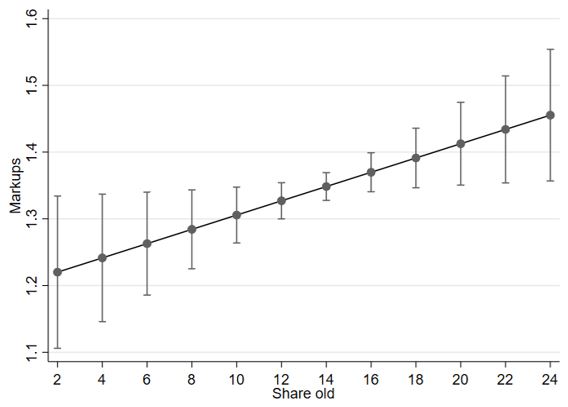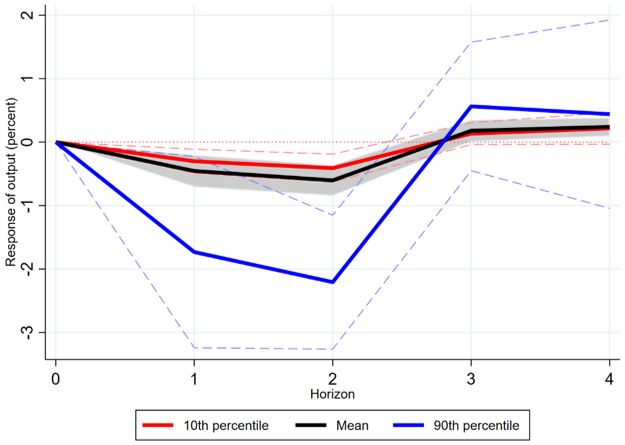

This Policy Brief is based on BoF Research Discussion Paper 16-2023. The views expressed are those of the author and do not necessarily represent the views of the Bank of Finland.
I provide theory and evidence suggesting a link between population aging and a flattening of the New Keynesian Phillips Curve. Cross-country evidence indicates a link between old-age dependency ratios and the markups charged by firms. A mechanism whereby households acquire deep habits in consumption and become less price sensitive as they age can explain this stylized fact. In turn, higher markups are indicative of a flattening of the Phillips Curve which raises the output costs of monetary tightening. Consistent with this view, I find evidence that the inflation-output trade-off faced by monetary policy is worse in aging economies. These results suggest that the challenges faced by central banks in aging economies may become even more pronounced going forward.
The cost-of-living crisis in many countries following the Covid-19 pandemic highlights the resurgence of inflation as a key economic concern. Many central banks, notably the European Central Bank, switched gears from a prolonged period of loose monetary policy to successively raising interest rates to levels last seen before the Global Financial Crisis. While inevitably necessary, monetary tightening can also be painful. In the words of Fed Chair Jerome Powell at the 2022 Jackson Hole Conference, while raising interest rates “will bring down inflation, they will also bring some pain to households and businesses. These are the unfortunate costs of reducing inflation.” How much pain and for how long depends on the potency of central banks’ tools in the fight to tame inflation and the structure of the economy. A key barometer is the slope of the Phillips Curve which captures the degree to which unemployment or economic activity worsens for each unit of inflation that monetary policy is able to bring down.
The latest evidence in this regard is somewhat disheartening. Recent estimates of the slope of the Phillips curve are notable in that they suggest a very flat Phillips curve indicating a high output cost to disinflation (e.g., Del Negro et al., 2020; Hazell et al., 2022). Several explanations have been put forth as to why the slope has flattened. In a recent paper (Ambrocio, 2023) I provide some theory and evidence linking population aging to the flattening of the Phillips Curve.
I first provide evidence that, across countries and time, the age structure matters for the markups that firms charge over the costs of production. Specifically, I find a positive association between old-age population shares and markups in developed countries. Figure 1 reports the marginal effects of the old-age population on markups from a dynamic panel cross-country regression. The results indicate that population aging can account for up to 10% of the increase in markups in OECD countries over the period 1980-2016.1 These estimates account for and are not due to broad macroeconomic trends and structural changes such as the share of Services in production, trade, and financial and economic development.
Figure 1: Markups and Age Dependency

Note: The figure plots the marginal effects of the share of the old (percentage of 65 and over in the population) on markups for OECD countries over the period 1980-2016 from a dynamic panel regression. The vertical bars denote 90% confidence intervals. The additional control variables are lagged markups, the share of the young and share female in the population, change in life expectancy, population growth, Real GDP, current account and total trade to GDP, government spending to GDP, savings to GDP, share of Services to GDP, unemployment and labor force participation rates, population density, stock market capitalization and credit to GDP. Data obtained from the World Bank and De Loecker and Eeckhout (2020).
A plausible explanation for the link between aging and markups is that people become accustomed to consuming specific products over time becoming less sensitive to prices as they age. This may be related to the phenomenon of niche consumption described by Neiman and Vavra (2023) and consumer inertia in Bornstein (2021) which indicates increasing brand loyalty over one’s lifetime. To derive the implications of this hypothesis for monetary policy, I develop a model of age-dependent deep habits in the New Keynesian framework.
I assume that people develop deep habits in consumption as they age and embed this assumption in a basic overlapping generations New Keynesian model. This assumption implies that the demand faced by firms become more price inelastic as populations age. Consequently, firms charge higher markups. When firms face costs to changing prices (a la Rotemberg), then the slope of the Phillips Curve – relating equilibrium output to inflation – flattens. In turn, this implies that the output cost monetary tightening increases as populations age.
This prediction of the model is borne out in the data. I estimate the output costs to monetary tightening across countries using state-dependent local projections with the age structure as the state variable and using the Jorda et al. (2020) trilemma instrument for monetary policy shocks. I find, as illustrated in Figure 2, that the output costs of monetary tightening subject to having the same impact on inflation is higher for countries and points in time with older populations. When the share of the old increases from 14% of the population (10th percentile in my sample) to 27% of the population (90th percentile), the cumulative output loss to a monetary tightening over a four-year horizon is eight times larger.
Figure 2: The output cost of monetary tightening

Note: The figure plots state-dependent local projections of the response of output to a monetary tightening that results in a 1 percentage point decline in inflation over a four-year horizon using the Trilemma instrument of Jorda et al. (2020). Responses are plotted for horizons 1 to four years ahead (horizontal axis) and when the state is equivalent to the 10th percentile (red), the average (black), and the 90th percentile (blue) of the old-age dependency ratio. The gray shaded area and the dotted red and blue lines delineate 90% confidence intervals.
In a recent paper, I provide a link between population aging and the slope of the New Keynesian Phillips Curve through a deep habits channel whereby households become more price inelastic as they age and firms charge higher markups. While by no means the most important or largest contributor to increasing market power or the declining slope of the Phillips Curve over time, population aging has non-negligible implications for price setting behavior and monetary policy. Given that population projections indicate that many countries are only at the beginning of the transition to an aging population, the results I document indicate that the challenges faced by central banks around the world may become more pronounced as populations continue to age.
Ambrocio, G., 2023. Demographic Aging and the New Keynesian Phillips Curve. Bank of Finland Research Discussion Paper 16-2023.
Bornstein, G., 2021. Entry and profits in an aging economy: The role of consumer inertia. Working Paper.
Del Negro, M., Lenza, M., Primiceri, G., Tambalotti, A., 2020. What’s Up with the Phillips Curve? Brookings Papers on Economic Activity, 301–357.
Hazell, J., Herreno, J., Nakamura, E., Steinsson, J., 2022. The Slope of the Phillips Curve: Evidence from U.S. States. Quarterly Journal of Economics 137, 1299–1344.
Jorda, O., Schularick, M., Taylor, A.M., 2020. The effects of quasi-random monetary experiments. Journal of Monetary Economics 112, 22–40.
Neiman, B., Vavra, J., 2023. The rise of niche consumption. American Economic Journal: Macroeconomics 15, 224–264.
By no means do I claim that population aging is the most important factor contributing to rising markups. Rather, I only show that aging has a non-negligible contribution to increases in markups among developed countries.